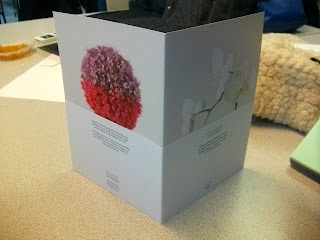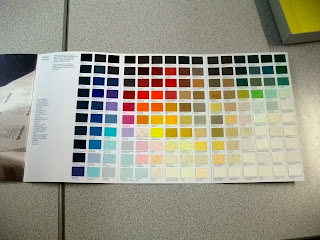Evolution Print are a Sheffield-based Print House which use both Litho Print and Digital Print to produce large amounts of prints or bespoke print jobs.
- Aluminium Plates and Full Colour Prints that can produce 1500 sheets an hour
- CTP Computers to Plate System
- Single sheet of cut paper of different sizes- SRA2 (The size of 16 A4's) to B1 (720x1020) in size but you must remember to leave a 20mm bleed around your work
- They won't print anything less than 70gms and will go up to 450gms
- They don't do a spot varnish or laminate and Binding is out of house
- They use 3 paper types: Gloss, Silk and Uncoated
- Uncoated is flatter, gives a hands-on organic feel but doesn't give a sharp image
- Gloss and Silk is sharper and usually for corporate
- Uncoated bulks up heavier in stock than in Silk- gives a hands-on quality whereas Silk is more compressed and thin
Differences between Litho and Digital Printing:
- Litho is better quality yet it is more expensive
- The maximum size for a Digital print is 2 pieces of A4 (SRA2) which is very limited
- Digital inks are powder based so you can feel the poster on top of the surface whereas Litho uses vegetable inks
- Litho allows you to use an extra, pure spot colour whereas Digital is a full colour process
Digital Costing Charge
- Click charge means a charge per sheet
- 5 to 10p for black and white or 30p for a colour sheet on just one size
- Litho is cheaper to print on a large scale
Litho Costing Charge
- Litho has an initial fixed cost based on Make Readies (£60) and Plate Costs for a Full Colour (£100)
- Make Readies include getting the inks to the right levels and printing 200 practise sheets to get the prints to the right standards
Printing Methods
- Work and Turn- One side printed and then you turn it so it goes on the back
- Sheet Work- One side printed then completely different on the other side (8 Plates more expensive)
Produced work for:
- Judge Gill
- Pete McKee
- Manchester City Football Club
- Lee Goater
- Activision
- Design Republic
- Manchester Modernist
Basic Mistakes made by Graphic Designers before Printing:
- Bleed- 3mm include Crop Marks and Trim
- Separate all Designs individually
- Don't send books as spreads, send as single pages- send as PDFs as well as original artworks
- For books, send covers separate
- If Spot Colours are not needed, set the to CMYK. Spot Colours don't print transparent- set as an Overprint
- Foils/ Separations/ Perforations- Set as a Spot Colour and Overprint so it can clearly be seen on the file
- Use correct image sizes and at 300dpi
- To save money where making a booklet, work in either a set of 8 or 16
- Using just 1 or 2 colour allows for it to be less expensive
- Consider whether you are going to see the benefit of using an expensive stock if it is going to get
covered in ink?
- They use cylinders rather than tins for ink so they can be reused and have less waste and water used
- They do work for charity as it is their corporate responsibility
- The inks and plates used are bought from local supplies but the paper isn't
- Coloured stocks are available but you can also use a white stock with a coloured tint behind it
After the talk, we had the chance to take some free samples away. I managed to get myself a business card and a large scale promotional publication. This meant that I was able to physically see and feel for myself the quality of the prints they produce.
 |
| Business Card |
 |
| Large Scale Promotional Publication |
As a year group, it has been suggested that we may get the opportunity to visit Evolution Print's Printing House in Sheffield to see for ourselves how they operate on a day-to-day basis. I think this would be an amazing opportunity if it actually came through as it would help our understanding so much more by visually being able to see the processes they use.



























































